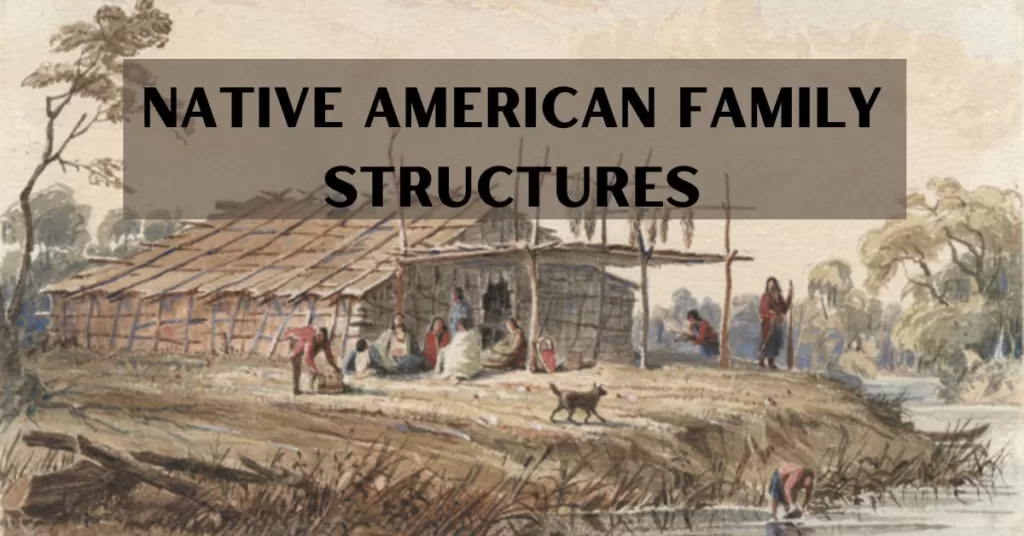Native American family structures have long been a topic of interest for historians, anthropologists, and curious minds alike. This article delves into the diverse and intricate world of indigenous family dynamics, exploring the hierarchy of Native American tribes, the importance of clan and kinship systems, and the largest tribal groupings in North America. We’ll also discuss the most powerful native tribe in history and their influence on American democracy, as well as the largest Native American structure, Cahokia, and the role of family in its society.
Table of Contents
The Hierarchy of a Native American Tribe
Delving into the complex world of Native American family structures, one of the key elements to explore is the hierarchy within a tribe. This hierarchy not only shaped day-to-day life but also influenced the broader social and political landscape of various Native American tribes. In this section, we will examine the roles and responsibilities of leaders, councils, and the distinct gender roles that contributed to the functioning of a tribe. As we explore these fascinating aspects of Native American culture, we will also touch upon the significance of kinship systems and the way they helped maintain tribal unity. So, let’s embark on this journey to uncover the intricacies of hierarchy in Native American tribes and appreciate the rich cultural heritage they represent.
The role of the chief or leader
In many Native American tribes, the chief or leader held a prominent position, responsible for the welfare and overall direction of the tribe. These leaders were typically chosen based on their wisdom, experience, and leadership qualities. In some tribes, the position was hereditary, while in others, it was earned through a series of tests or accomplishments. Regardless of the selection process, the chief’s primary role was to provide guidance and make crucial decisions that affected the entire community.
Councils and decision-making processes
While the chief was an important figure, they didn’t hold absolute power. Councils played a significant role in the decision-making process within Native American tribes. These councils, composed of respected members such as elders or other tribal leaders, discussed pressing issues and offered their insight before any decision was made. This collaborative approach to governance promoted unity and ensured that the interests of the tribe were considered from various perspectives.
Gender roles and responsibilities within the tribe
Native American tribes had distinct gender roles and responsibilities that contributed to the overall functioning of the community. In many tribes, men were responsible for hunting, fishing, and providing physical protection, while women took charge of the domestic sphere, such as farming, cooking, and raising children. However, it’s essential to recognize that these roles were not rigid across all tribes. In some communities, women held positions of power and influence, while in others, men were involved in tasks traditionally considered feminine. The diversity in gender roles across different Native American tribes highlights the rich cultural tapestry that makes up these unique societies.
In conclusion, the hierarchy within Native American tribes was a complex and fascinating system, intricately woven with chiefs, councils, and gender roles. Understanding this hierarchy allows us to appreciate the intricate social dynamics that shaped Native American family structures and the overall functioning of their communities.
The Importance of Clan and Kinship Systems
As we continue to explore Native American family structures, it is crucial to delve into the importance of clan and kinship systems. These systems played a vital role in defining the social fabric of various tribes and contributed to the stability and cohesion of their communities. In this section, we will examine the intricacies of blood relations, extended family networks, and how the concept of clans maintained tribal unity. Join us as we uncover the fascinating ways in which Native American tribes nurtured their relationships and built strong, interconnected communities through their unique clan and kinship systems.
Blood relations and extended family networks
Blood relations and extended family networks were integral components of Native American societies, transcending the nuclear family structure that is common in many Western cultures. In these tight-knit communities, individuals were connected through a complex web of familial ties, with cousins, aunts, uncles, and even more distant relatives playing significant roles in each other’s lives. These extended family networks provided support and fostered a sense of belonging, ensuring that individuals could rely on their kin in times of need or crisis.
The role of clans in maintaining tribal unity
Clans played a crucial role in maintaining tribal unity, acting as the backbone of Native American social structure. A clan was typically made up of several related families who traced their lineage to a common ancestor. Clans had their own customs, rituals, and responsibilities within the tribe, contributing to a diverse and dynamic social landscape.
In many Native American tribes, individuals were identified by their clan affiliation, and this identification determined their roles, duties, and even marriage prospects. By assigning specific responsibilities to each clan, tribes were able to distribute labor effectively and ensure that essential tasks were carried out. Moreover, the strong sense of identity fostered by clan affiliation fostered loyalty and cooperation among its members, helping to maintain harmony and cohesion within the tribe.
In summary, the importance of clan and kinship systems in Native American family structures cannot be overstated. These systems fostered strong connections among tribal members, created a sense of identity and belonging, and contributed to the overall unity and stability of their communities.
The 3 Largest Native American Tribal Groupings
In our quest to understand Native American family structures, it’s essential to examine the three largest tribal groupings that have left an indelible mark on the history and culture of Indigenous peoples in North America. The Navajo Nation, Cherokee Nation, and Sioux Nation each have their own unique family structures, customs, and practices that provide valuable insights into the diversity of Native American family life. In this section, we will take a closer look at the distinctive characteristics of each of these tribal groupings and how their family structures have shaped their respective identities and ways of life. Join us as we venture into the vibrant world of the Navajo, Cherokee, and Sioux Nations, and discover the rich tapestry of family traditions that define these remarkable tribes.
Navajo Nation: family structures and customs
The Navajo Nation, known for its rich cultural heritage and stunning landscapes, boasts a unique family structure. At the core of Navajo society lies the matrilineal clan system, in which an individual’s identity, social standing, and inheritance are determined by their mother’s clan. Within this system, women hold significant power and influence, often acting as the heads of their households. Navajo families value strong kinship ties, and extended family members actively participate in raising children and maintaining a close-knit community. Traditional customs, such as Kinaaldá, a coming-of-age ceremony for girls, further emphasize the importance of family and community in Navajo life.

Cherokee Nation: family structures and practices
The Cherokee Nation, one of the most well-known Native American tribes, also features a matrilineal clan system. However, the Cherokee clan system is distinct in its organization of seven clans, each with its own unique responsibilities and cultural practices. Within Cherokee families, women were responsible for farming, cooking, and childcare, while men focused on hunting, warfare, and diplomacy. The Cherokee people practiced clan exogamy, meaning that individuals were required to marry someone from a different clan. This practice strengthened inter-clan relationships and promoted tribal unity.

Sioux Nation: distinctive family structures and traditions
The Sioux Nation, made up of three major divisions – the Dakota, Nakota, and Lakota – is renowned for its warrior tradition and spiritual beliefs. Sioux family structures were largely based on the extended family, with several generations living together in close proximity. The Sioux people placed great importance on kinship, with close relationships between grandparents and grandchildren being particularly cherished. The tiyospaye, a kinship-based social unit, was the foundation of Sioux society, providing support and resources to its members. In Sioux culture, men and women had distinct roles; men were primarily hunters and warriors, while women managed domestic tasks and food processing. However, it’s important to note that gender roles were more fluid in some aspects, with the presence of the Winkte, or Two-Spirit individuals, who often took on roles and responsibilities associated with the opposite gender.

The Most Powerful Native Tribe
As we delve deeper into the fascinating world of Native American family structures, it’s impossible not to ponder which tribe could be considered the most powerful in history. While power can be defined and measured in various ways, such as military prowess, cultural influence, or economic strength, there is one tribe that stands out as a formidable force in the annals of Native American history. In this section, we will explore the tribe that has earned this distinction and examine the unique family structure and customs that contributed to its immense power and influence. Join us as we uncover the story of this remarkable tribe and discover how its family traditions shaped its legacy as the most powerful Native tribe in history.
The Iroquois Confederacy
The Iroquois Confederacy, also known as the Haudenosaunee or the Six Nations, was a powerful alliance of Native American tribes in the northeastern region of North America. Comprised of the Mohawk, Oneida, Onondaga, Cayuga, Seneca, and later, the Tuscarora tribes, the Iroquois Confederacy stood as a formidable force in the region for centuries.
Central to the confederacy’s success was its unique family structure, which played a crucial role in fostering unity and cohesion among the member tribes. Like many other Native American tribes, the Iroquois followed a matrilineal clan system, where descent and inheritance were traced through the mother’s lineage. This system established strong bonds among clan members, as well as between different tribes within the confederacy.
In Iroquois society, women held significant power and influence. Clan mothers, the female heads of each clan, were responsible for selecting chiefs, known as sachems, who would represent their respective clans in the Grand Council – the confederacy’s central governing body. This unique balance of power between men and women helped to ensure that decisions were made with the best interests of the entire community in mind.
Another key aspect of Iroquois family structure that contributed to the confederacy’s success was the emphasis on communal living and cooperation. Iroquois families often lived in large longhouses, which accommodated multiple generations and families of the same clan. This close-knit living arrangement fostered a strong sense of unity and shared responsibility among clan members, allowing the Iroquois people to pool their resources and work together effectively in times of need.
Influence of Iroquois Family Structures on American Democracy
One of the most remarkable aspects of the Iroquois Confederacy is the influence its family structures and governance systems had on the development of American democracy. The core principles of the Iroquois Confederacy, such as the emphasis on consensus-building and the equal representation of men and women in decision-making, provided a model for early American colonists and founding fathers as they sought to create a new system of governance for their burgeoning nation.
The matrilineal clan system of the Iroquois, which gave women a significant role in the selection of chiefs and the maintenance of peace, demonstrated the potential for a more balanced and inclusive form of governance. This example of gender equality likely influenced early American thinkers, who were grappling with the challenges of creating a fair and representative democracy.
How the Iroquois Great Law of Peace inspired the U.S. Constitution
The Iroquois Great Law of Peace, a foundational document that established the guiding principles and governance structure of the Iroquois Confederacy, is thought to have had a profound impact on the drafting of the U.S. Constitution. The Great Law of Peace outlined a system of checks and balances, which ensured that no single tribe or individual could wield too much power. This concept was mirrored in the U.S. Constitution, which similarly created a system of checks and balances among the executive, legislative, and judicial branches of government.
Moreover, the Iroquois Confederacy’s emphasis on unity, collaboration, and shared responsibility among its member tribes provided an inspiring example for the founding fathers as they sought to create a strong and united nation. The Iroquois Great Law of Peace’s focus on preserving peace and fostering harmony among diverse tribes resonated with the American vision of a unified and just society.
The Largest Native American Structure and Its Connection to Family
In our exploration of Native American family structures, it’s fascinating to consider the connection between these family systems and the architectural achievements of various tribes. As we examine the largest Native American structure ever built, we’ll uncover the ways in which family dynamics and social organization played a role in its construction and purpose. Join us on this captivating journey into the past, as we delve into the story of this magnificent structure and reveal the intricate link between family values and architectural ingenuity in Native American societies.
Cahokia: the significance of the ancient city and its social organization
Cahokia, located in present-day Illinois, stands as a testament to the incredible achievements of Native American societies. This ancient city, which was home to the Mississippian culture, thrived between AD 1050 and 1350 and is considered the largest pre-Columbian settlement north of Mexico. At its peak, Cahokia may have had a population of up to 20,000 people, rivaling the size of contemporary European cities like London or Paris.
Central to Cahokia’s significance is its impressive architectural centerpiece, Monks Mound, which stands as the largest earthen mound in North America. Rising to a height of 100 feet and covering an area of 14 acres, Monks Mound demonstrates the immense skill and organization required to construct such a monumental structure.
The social organization of Cahokia offers valuable insights into the connection between family structures and the construction of the city. Like other Native American societies, Cahokia was organized around kinship networks, which were likely responsible for the construction and maintenance of its many mounds and plazas. These familial groups formed the backbone of Cahokian society, providing labor, resources, and support for the city’s monumental endeavors.
Moreover, the people of Cahokia practiced complex agricultural techniques, which allowed them to sustain their large population and support the construction of their impressive structures. The cultivation of crops, such as maize, was likely a communal effort, with families working together to ensure the success of their community.
The Role of Family Structures in Cahokia Society
As we continue our exploration of Cahokia and its remarkable achievements, it’s essential to delve deeper into the role that family structures played in shaping this unique society. In this section, we will examine the various aspects of Cahokian family life, from kinship networks to the division of labor and the importance of communal cooperation. Understanding these familial dynamics will shed light on how the people of Cahokia were able to create a thriving and sophisticated civilization, as well as offer valuable insights into the broader context of Native American family structures. Join us as we uncover the intricate connections between family life and the extraordinary accomplishments of the ancient Cahokian society.
Clans, kinship, and social hierarchy within Cahokia
At the heart of Cahokian society were its family structures, which played a vital role in shaping the city’s social organization and hierarchy. Much like other Native American tribes, Cahokia was comprised of clans – groups of families that shared a common ancestor. These clans formed the basic building blocks of Cahokian society, and each clan had its own unique customs, traditions, and responsibilities.
Kinship networks within Cahokia were extensive, incorporating not only blood relatives but also individuals related through marriage or adoption. These connections created a strong sense of unity and cooperation among clan members, as well as between different clans. The intricate web of relationships facilitated the sharing of resources, knowledge, and labor, which was crucial to the success of the city’s large-scale construction projects and agricultural endeavors.
In terms of social hierarchy, Cahokian society was likely stratified, with certain clans or individuals holding more power and influence than others. This may have been based on factors such as clan size, ancestry, or the possession of valuable resources or skills. However, it’s important to note that while there was a social hierarchy within Cahokia, the city’s success relied heavily on the collaboration and cooperation of all its members.
Conclusion
In conclusion, the exploration of Native American family structures offers valuable insights into the richness and diversity of indigenous cultures throughout history. From the hierarchy of tribes and the role of clans in maintaining unity to the distinctive customs and practices of the largest tribal groupings, these unique family dynamics have shaped the social organization and success of native societies across the continent.
As we seek to better understand and appreciate the depth of Native American heritage, it is crucial to preserve and honor these cultural traditions. By doing so, we not only pay tribute to the resilience and adaptability of indigenous peoples but also ensure that their remarkable achievements and contributions to human history continue to be recognized and celebrated. Ultimately, the study of Native American family structures highlights the importance of embracing cultural diversity and the invaluable lessons it can teach us about the strength and beauty of human connection.

Joyce Ann Tyldesley is a renowned British archaeologist, Egyptologist, writer, and broadcaster.






